30.01.2007
Corus Tournament in Wijk aan Zee: a Creative Survey (Rounds 7-8)
Round 7
S. Tiviakov (2667) – S. Kariakin (2678) [B22]
1.e4 c5 2.c3 ¤f6 3.e5 ¤d5 4.¤f3 ¤c6 5.d4 cxd4 6.cxd4 d6 7.Ґc4 ¤b6 8.Ґb5 dxe5 9.¤xe5 Ґd7 10.¤xd7 Јxd7 11.¤c3 e6 12.0–0
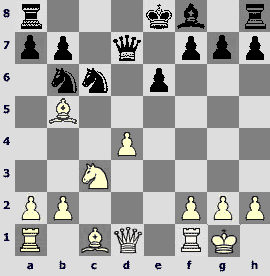
12...¦d8! Seriozha Kariakin is up on the latest theory trends;to my mind, 12...¦d8 – is the most precise way to equality. Black holds his own also after 12...Ґe7, the crucial game here is the following: 13.Јg4 0–0 14.Ґxc6 Јxc6 15.Ґh6 Ґf6 16.¦ad1 Јd7 17.¤e4 Јd8 18.¦d3 ўh8 19.Ґd2 Јd5 20.Ґb4 ¦fc8 21.¤xf6 gxf6 22.Ґe7 Јg5 23.Јxg5 fxg5 24.Ґxg5 ¤d5 25.¦d2 ўg7 26.¦fd1 a5 27.ўf1 a4, and in Movsesian – Kotronias (Istanbul 2003) the opponents have agreed to a draw.
Still I would not want to choose such a complex way to a draw in this inoffensive 2.c3-variation. Artyom Timofeev used to play 12...¦c8 here, and also drew confidently; still I do not like this move as after it a d4-d5 breakthrough in different versions can follow.
13.Ґe3. The game seems more interesting after13.a4, but even here after 13...a6 14.Ґxc6 Јxc6 15.Ґg5 f6 16.Ґe3 Ґe7! (surely not 16...Ґb4? because of 17.d5!, and white queen with a tempo gets to g4) 17.Јb3 ¤d5 18.¦fc1 Јb6 Black has no problems (Kindermann – Sakaev, Germany 2006).
13...Ґe7 14.Јg4 0–0 15.¦ad1 g6 16.¦fe1 a6 17.Ґd3 Ґf6 18.Ґe4 ¤xd4 19.Ґxb7 Јxb7 20.Ґxd4 Ґxd4 21.¦xd4. After probable 21...¤d5 the knights get exchanged into a bargain and no material is left to play with. Ѕ–Ѕ
R. Ponomariov (2723) – V. Topalov (2783) [E71]
1.d4 ¤f6 2.c4 g6 3.¤c3 Ґg7 4.e4 d6 5.h3 0–0 6.Ґg5 c5. From King's Indian Defense Veselin sets out the game on the path of Benoni Defense.
7.d5 e6 8.Ґd3 exd5 9.cxd5 ¦e8 10.¤ge2 ¤bd7 11.0–0 h6 12.Ґe3 ¤e5 13.a4 ¤xd3 14.Јxd3 b6 15.¤g3. 15.f4 is bad because of 15...¤xe4.
15...¤h7 16.f4 h5 17.f5 h4
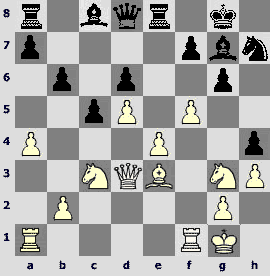
18.fxg6?! Why remove the wedge, "killing" the c8-bishop, on your own free will? 18.¤ge2 seems more logical to me.
18...fxg6 19.¤ge2 g5 20.¦f2 a6 21.¦af1 ¦a7 22.¤b1!? Ruslan Ponomariov finds a piece, that occupies an unfitting place – the knight sets out over d2 to f3, and maybe, given the opportunity, to c4.
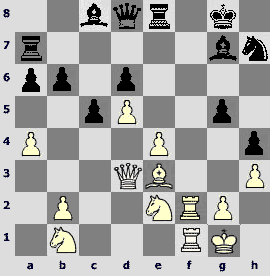
22...g4!? A risky, but not obligatory move, play gets wild to the limit. The main drawback of the last Black's move is that the f4-square becomes accessible to the white knight.
23.hxg4 Ґxg4 24.¤d2. Another possibility is 24.¤f4 ¤g5 25.¤d2, with very complex play as well.
24...Ґxb2!? A very important decision,24...¤g5 looks like a more reliable alternative, with complex play.
25.¤c3. Play of a 25.¤c4 Ґg7 26.e5-kind seems too much of a gambit.
25...¦g7 26.¤c4 Ґxc3 27.Јxc3 Ґh5 28.Ґf4. 28.¦f5 Ґe2 29.¦1f2 Ґxc4 30.Јxc4 ¤g5 31.Ґxg5 ¦xg5 32.Јxa6 ¦xf5 33.exf5 Јf6 would have lead to a position where the risks were all White's. 28...¦xe4 29.¤e3 Јf6!
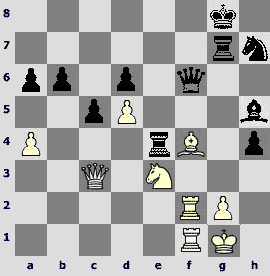
Now the position can surely be evaluated in Black's favor. White's play along the f-file is unsuccessful, and Black has already bagged some extra material. The position of the h7-knight is especially fine – it not only covers the f6- and f8-squares, but is also ready to spring out to g5.
30.Јc2 Ґg6 31.¤g4 Јd4 32.¤h6+ ўh8 33.Ґc1 ¦e1 34.Јd2 ¦xf1+ 35.ўxf1 Ґd3+ 36.ўg1 ¤g5 37.ўh2 ¤e4 38.¦f8+ ўh7 39.Јf4 ¤c3 40.Јxd4 cxd4 41.¤f7 ¤e4 42.Ґb2 Ґf1 43.¦h8+ ўg6 44.¦xh4 ўxf7 45.¦f4+ ўg8 46.¦xf1 ¦h7+ 47.ўg1 d3 48.¦d1 ¦h1+ 49.ўxh1 ¤f2+ 50.ўg1 ¤xd1 51.Ґc1 ¤b2 52.ўf2 ¤xa4 53.Ґf4 ¤c3 54.ўf3 a5 55.Ґd2 ¤b1 56.Ґf4 a4 57.Ґxd6 d2 58.ўe2 ¤c3+ 0–1
An extremely complex game – even in calm conditions with the help of a computer it is difficult to find out, exactly when the position has become favorable for Black and where has Ruslan Ponomariov made a decisive mistake. Computer fails to give answers to these questions; I personally as a player feel that exchanging his light-squared bishop in the beginning of the game has been "kinda wrong", but is this really a mistake big enough to lose this game?
М.Carlsen (2690) – P. Svidler (2728) [C88]
1.e4 e5 2.¤f3 ¤c6 3.Ґb5 a6 4.Ґa4 ¤f6 5.0–0 Ґe7 6.¦e1 b5 7.Ґb3 0–0
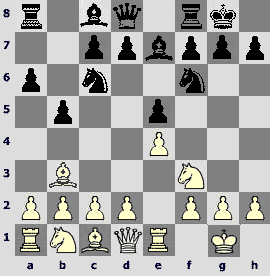
8.a3. Judging by the White's last move, the theory asserts, that in this classical variation Black feels quite OK! I'd like you to look at this position with a "fresh" eye, leaving behind all your theoretical knowledge (if you haven't got any, then your task would be still easier). So how does 8.a3 impress you?
8...Ґc5. Any answer is good, but Peter's reaction is especially to my liking – he transposes the game into a favorable branch of the Arkhangelsk variation, the dark-squared bishop can have a breath of fresh air, as it is not constrained by the d6-pawn any more.
9.c3 d6 10.d4 Ґb6 11.Ґe3 h6 12.h3 ¦e8 13.¤bd2 Ґb7. The position is equal.
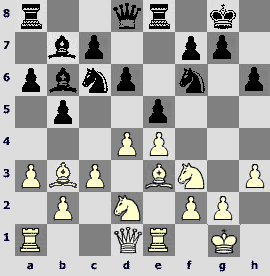
14.dxe5 dxe5 15.Ґxb6 cxb6 16.¤h2 Јe7 17.¤g4 ¦ad8 18.¤xf6+ Јxf6 19.Јe2 ¤a5 20.Ґa2 Ґc8 21.¤f1 Јg6. Black has the e4-pawn in his sights, preventing the knight from springing out on e3.
22.ўh2 Ґe6 23.Ґxe6 ¦xe6
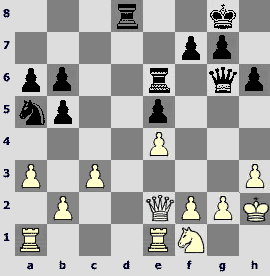
24.a4? Playing at give-away; to simplification and a probable draw leads 24.¦ad1 ¦ed6 25.¤g3.
24...¤b3 25.¦ad1 ¦xd1 26.¦xd1 bxa4 27.Јxa6 Јxe4 28.Јc8+ ўh7 29.¦d8 Јf4+ 30.¤g3 ¤d2
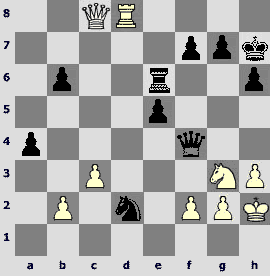
31.h4! A wonderful, hard-to-find chance shows great potential of the Norwegian boy (for the time being I personally regard him just so in contrast to, for example, Seriozha Kariakin, no less talented but much more mature chessplayer, who has already realized himself to a great extend, and so commits much less positional blunders ).
31...Јxh4+ 32.ўg1
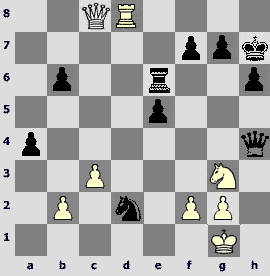
32...e4 33.¦xd2? The only possible course of actions is 33.¦h8+ ўg6 34.Јg8, with whole lot of wild threats. Black has an advantage, but the play is not easy at all, and I can see no clear forced way.
33...e3 34.¦d3 Јf4 35.¦xe3 ¦xe3 36.fxe3 Јxg3 37.Јf5+ Јg6 38.Јd5 Јe6 39.Јd4 g6 40.Јxa4 Јxe3+ 41.ўh2 h5 42.Јd1 ўg7 43.Јd6 f6 44.Јc7+ ўh6 45.b4 ўg5 46.Јc6 Јe5+ 47.ўg1 b5 0–1
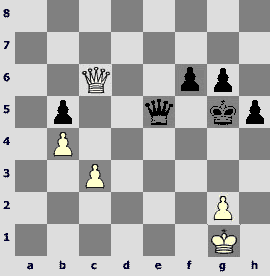
The decision to surrender seems a bit premature – the position is, of course, lost, but there are still some practical chances for a salvation.
V.Аnand (2779) – Т.Radjabov (2729) [B33]
1.e4 c5 2.¤f3 ¤c6 3.d4 cxd4 4.¤xd4 ¤f6 5.¤c3 e5 6.¤db5 d6 7.Ґg5 a6 8.¤a3 b5 9.¤d5 Ґe7 10.Ґxf6 Ґxf6 11.c3 Ґg5 12.¤c2 0–0 13.a4 bxa4 14.¦xa4 a5 15.Ґc4 Ґd7 16.0–0 ¦b8 17.¦a2 ўh8 18.¤ce3 g6 19.Јd3 f5 20.b3 Ґh6 21.¦d1 Јh4 22.f3 Јg5 23.¤f1 Јd8 24.ўh1
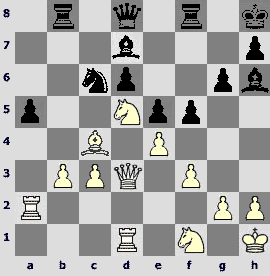
The opponents have not deviated much from the well-known theory, when all of a sudden there follows an anti-positional 24...f4? After this weird move the game is strategically won for White, so let us watch Vishy Anand failing to "convert a penalty".
25.¤d2 Ґg5 26.Ґb5 ¤b4 27.¤xb4 Ґxb5 28.c4 Ґxc4 29.¤xc4 ¦xb4 30.Јd5 Јc7 31.¤xd6 Ґf6 32.¦xa5 ¦xb3 33.¦c5 Јb8 34.¦cc1. The simplest way is 34.¤f7+ ўg7 35.¤xe5, and a rook ending must be lost for Black because of the f4-pawn which is sadly cut off from its friends.
34...¦b2 35.Јe6 Јb3
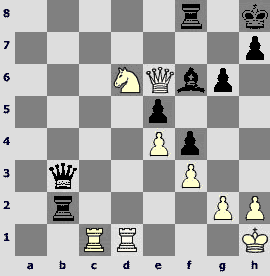
36.Јd7. Winning is 36.¤c4! ¦a2 (36...¦c2 37.Јd6 Ґg7 38.¤xe5) 37.¦b1 Јc2 38.¦g1. Having successfully defended himself from the threat of mate, White is quite eager to start harvesting, the principal "ripe fruit" being the a5-pawn.
36...¦c2 37.¤e8 ¦xc1 38.¦xc1 Јa3 39.¦b1 Јa2 40.¦d1 Јf7 41.¤xf6 Јxf6 42.Јc7 ¦f7 Ѕ–Ѕ
L. Aronian (2744) – V.Кramnik (2766) [D17]
1.d4 d5 2.c4 c6 3.¤f3 ¤f6 4.¤c3 dxc4 5.a4 Ґf5 6.¤e5 e6 7.f3 c5 8.e4 Ґg6 9.Ґe3 cxd4 10.Јxd4 Јxd4 11.Ґxd4 ¤fd7 12.¤xd7 ¤xd7 13.Ґxc4 a6
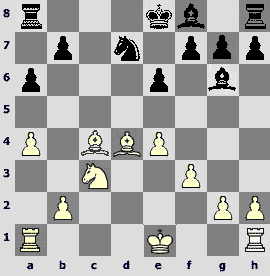
14.h4. An attempt to make a minor improvement in comparison with a game of the Elista match Topalov – Kramnik, in which after 14.ўe2 ¦g8! Vladimir managed to achieve a draw.
14...¦c8 15.Ґa2 h6 16.¦c1 Ґc5 17.¤e2 0–0 18.0–0 Ґd6 19.Ґe3 ¤e5 20.¤f4 ¦xc1 21.¦xc1 Ґh7 22.ўf1 ¦b8 23.ўe2 ўf8 24.g4 ўe7 25.¤g2 f6 26.h5 Ґg8 27.Ґa7 ¦a8 28.Ґb6 Ґf7 Ѕ–Ѕ
The final position is still more pleasant-looking for White, but Black has managed to solve his principal problem of the dark-squared bishop, so the draw is highly probable. So, in all probability foreseeing the time trouble, the opponents have agreed to a draw.
D.Navara (2719) – L. van Wely (2683) [B90]
1.e4 c5 2.¤f3 d6 3.d4 cxd4 4.¤xd4 ¤f6 5.¤c3 a6
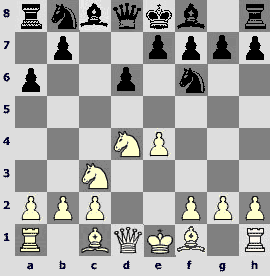
6.h3!? A rare move, but it is not devoid of poison. 6...g6 7.g4 Ґg7 8.Ґg2 h5?!

White means to play in the center and not along the h-file, and so Loek van Wely's reaction seems dubious.
9.g5 ¤fd7 10.Ґe3 ¤c6 11.Јd2 0–0 12.0–0–0 ¤de5 13.b3. Black light-squared bishop is badly restricted, the knights have no bearing squares, and the overall lack of space is evident. The advantage is on the White's side.
13...Јa5 14.f4 ¤xd4 15.Ґxd4 ¤c6 16.Ґxg7 ўxg7 17.ўb2 Ґe6 18.¦hf1 ¦ac8 19.Јe3?! Strong is 19.a3, depriving the black knight of the d4-squre into the bargain.
19...¤b4? Black misses a chance to acquire active counterplay with 19...b5! Tactical justification of Black's idea is seen in the variation 20.f5 ¤e5 21.fxe6 b4 22.¤a4 Јxa4.
20.¦f2 Јc5 21.Јxc5 ¦xc5 22.¤a4. 22.a3 ¦fc8 23.¦f3 won't do because of 23...¤a2!
22...¦c7 23.f5 b5 24.¤c3 ¦fc8 25.fxe6 ¦xc3 26.¦dd2 ¦3c7
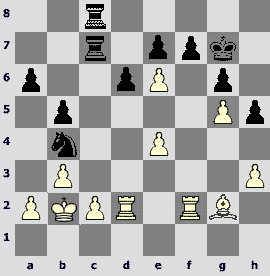
27.e5! David Navara is true to the classic principles, depriving Black of an important square. He is not seduced even with the win of a pawn– 27.¦xf7+ ўg8 28.¦ff2 ¤c6. Having set his knight on e5 Black acquires considerable chances for a draw.
27...fxe6 28.exd6 exd6 29.a3 ¤d5 30.Ґxd5 exd5 31.¦xd5 ¦c6 32.¦fd2 ¦d8 33.h4 ¦d7 34.¦5d3 a5? Creating additional weaknesses in his own camp; more stubborn is to "hold the fort" with 34...¦d8, although even in this case White is closer to a win than Black is to a draw.
35.¦d5 ¦b6 36.¦2d4 a4? 36...¦e7 37.¦xd6 ¦xd6 38.¦xd6 ¦e4 39.¦d5 ¦xh4 40.¦xb5 should have lead White to a win, but it would still made him worry a lot.
37.¦b4 ¦db7 38.¦bd4? David is imprecise already on the stage of realization, to an easy win leads 38.bxa4 bxa4 39.c3! Black rooks cannot escape from the b-file, and an exchange on b4, turning White's pawn structure into a strong monolith, is equal to surrender.
38...¦e7 39.¦xd6 ¦xd6 40.¦xd6 ¦e4 41.¦b6 ¦xh4 42.¦xb5 ¦g4 43.bxa4
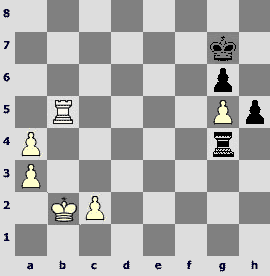
43...h4? Captures are the best moves, especially when one is unable to evaluate the variations or to calculate them to an end. This stock phrase relates to the situation on the board in full measure. The draw was achievable after 43...¦xa4 44.ўb3 ¦f4! 45.a4 h4 46.a5 h3 47.¦b7+ ¦f7 48.¦b4 ¦f5.
44.a5 h3 45.¦b7+ ўg8 46.¦b3 ¦xg5 47.¦xh3 ¦xa5 48.c4 ўf7 49.ўb3 g5? Chances for salvation remained after 49...ўe7 или 49...ўe6, aiming to transfer the king to the queenside. White would have answered 50.¦d3, and all the struggle is still in full swing.
50.ўb4

50...g4? Another mistake, and for once it is a final one.The last hope chance is50...¦a8 – in comparison with the continuation chosen during the game; Black wins a tempo necessary for transferring the king to the queenside. Moreover, his rook would become active and could give checks; for instance on 51.ўb5 Black plays 51...¦b8+ 52.ўa6 ўe6!, his king threading his way to the queenside.
51.¦g3 ¦g5 52.c5. In spite of the unfortunate position of the rook, the white king manages to get much too far, and Black is helpless against two pawns rushing to be promoted.
52...ўe6 53.ўb5 ўe5 54.ўb6 ўf4 55.¦g1 ¦g8 56.c6 ¦b8+ 57.ўc5 ¦b3 58.a4 ¦c3+ 59.ўb5 g3 60.a5 ¦c2 61.a6 ¦b2+ 62.ўc5 ¦c2+ 63.ўb6 ¦b2+ 64.ўc7 ¦a2 65.ўb7 ¦b2+ 66.ўc8 ¦a2 67.c7 1–0
А.Shirov (2715) – А.Motylev (2647) [C42]
1.e4 e5 2.¤f3 ¤f6 3.¤xe5 d6 4.¤f3 ¤xe4 5.¤c3 ¤xc3 6.dxc3 Ґe7 7.Ґf4 0–0 8.Јd2 ¤d7 9.0–0–0 ¤c5 10.Ґe3 ¦e8 11.Ґc4 Ґe6 12.Ґxe6 ¤xe6 13.h4 Јd7 14.Јd5. A novelty, but not a dangerous one. Previously the usual move was 14.Јd3 (the latest example is the game Kariakin – Kramnik in the first round).

14...Јa4 15.¤g5 Јc6 16.c4 Јxd5 17.cxd5 ¤xg5 18.hxg5 f6 19.gxf6 Ґxf6. The endgame is equal, but as Alexey Shirov does not belong to the Miniature Draw Lovers club, the struggle has been going on to the end.
20.c4 ¦e4 21.b3 ¦ae8 22.ўc2 h6 23.ўd3 Ґg5 24.Ґxg5 hxg5 25.¦h5 ¦f4 26.f3 ¦f5 27.¦dh1 ўf7 28.¦h8 ¦fe5 29.¦xe8 ¦xe8 30.g4 a5 31.a3 b6 32.¦a1 ўf6 33.b4 ¦a8 34.ўc3 axb4+ 35.ўxb4 g6 36.¦e1 ўf7 37.a4 ¦a5 38.¦e4 ¦c5 39.¦e3 ¦a5 40.¦e2 ¦c5 41.¦e4 It is so sad to see that even such a visionary and romantic of chess as Alexey Shirov can do nothing against Petroff's Defense. Ѕ–Ѕ
Round8
L. van Wely (2683) – R.Ponomariov (2723) [E10]
1.d4 e6 2.c4 ¤f6 3.¤f3 ¤c6
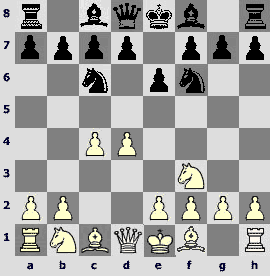
Usually amateurs play thus, but I remember that Viorel Bologan used to play quick chess against me in this way even twice, getting satisfactory positions in the openings at that.
4.a3 d5. Here Viorel used to choose another course already, preferring 4...g6 and switching to well-known and dear to his heart King's Indian Defense formations.
5.Ґg5 Ґe7 6.e3 h6 7.Ґh4 0–0 8.¤c3 b6 9.¦c1. On 9.Ґd3, 9...dxc4 10.Ґxc4 ¤a5 could have followed with subsequent 11...c5, and Black is close to equality.
9...Ґb7 10.cxd5
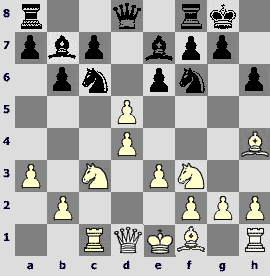
10...¤xd5. Naturally, Black takes with the knight – the b7-bishop is better not to be blocked needlessly.
11.Ґg3 Ґd6! The exchanges are fine with Black; the e7-square becomes free for the c6-king in passing.
12.Ґd3 ¤ce7 13.0–0 ¦c8 14.¤e4. 14.¤xd5 is also not bad, permitting to retain a small but stable advantage.
14...¤f5! 15.Јa4. The queen leaves for the "farside". I do not like this Loek's move together with the next two ones. After exchanging any pieces on d6 White's position would have been just a little bit more pleasant, 15.Ґe5!? also seems interesting.
15...a6 16.¤xd6 cxd6 17.¦xc8 Јxc8 18.Ґxf5 exf5 19.Ґxd6. For the win of a pawn White has weakened the light squares and given up the c-file. I think he was lucky to get away with a draw.
19...¦e8 20.Ґe5 ¦e6 21.¤e1 ¦c6 22.Јb3 ¦c1 23.¤d3 ¦xf1+ 24.ўxf1
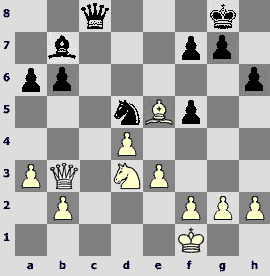
24...a5! Saving the a6-square for the bishop just in case and depriving the white knight of the b4-square.
25.ўe1 Јe6 26.ўd2 ўh7 27.Јc2 f6 28.Ґb8 g5! And now the white knight is deprived of the f4-square and in passing the dark-squared bishop is getting constricted.
29.h3 ўg7 30.Јc4 h5 31.Ґh2 h4 32.¤e1 Ґc6 33.Јd3 Јd7 34.ўc1 Ґb5 35.Јc2 Ґf1 36.e4 fxe4 37.Јxe4 Јc6+ 38.ўd2 Јb5 39.ўc1 Јe2 40.Јxe2 Ґxe2 41.g3 hxg3 42.fxg3 ўg6 43.ўd2 Ґf1 44.h4 ўh5 45.hxg5 fxg5 46.¤c2 ўg4 47.¤e3+ ¤xe3 48.ўxe3 Ґg2 49.d5 Ґxd5 50.Ґg1 ўxg3 51.Ґf2+ ўg2 52.Ґe1 Ґc6 53.Ґc3 g4 54.ўf4 Ґd7 55.Ґe1 ўf1 56.Ґh4 b5 57.ўe4 Ѕ–Ѕ
Black initiative turns out to be enough for no more than a draw. I suppose that strengthening should be thought in the moves from 20 to 23, when Black has carried out the unprofitable exchange.
А.Shirov (2715) – S.Tiviakov (2667) [B37]
1.e4 c5 2.¤f3 ¤c6 3.d4 cxd4 4.¤xd4 g6 5.c4 ¤f6 6.¤c3 d6 7.¤c2 Ґg7 8.Ґe2 ¤d7 9.Ґd2 ¤c5 10.b4 ¤e6 11.¦c1 a5 12.b5 ¤cd4 13.¤xd4 Ґxd4 14.Ґh6 Ґxc3+ 15.¦xc3 b6 16.0–0 Јc7 17.¦e1 f6
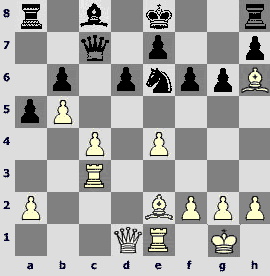
Black has played the opening defiantly, leaving their king in the center, and, as it often happens in such cases, there follows a blow to the most fortified place.
18.c5! When Alexey Shirov has seen such a move, which follows from demands of the position, it is quite unnecessary to persuade him to make it.
18...¤xc5. On 18...dxc5 there is a strong answer 19.e5, both immediately and after preliminary 19.Ґc4. And if 18...bxc5, then 19.Ґc4 and f2-f4, also developing a strong attack.
19.Ґg7 ¦g8 20.Ґxf6?! Alas, a mistake, although a not obvious one. Stronger is 20.Јd5 ¦xg7 21.Јxa8 Јb7 22.Јxb7 Ґxb7 23.f3, and Black faces a long fight for a draw.
20...exf6 21.Јd5 Ґe6 22.Јxa8+ ўe7 23.Јc6
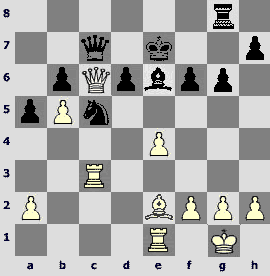
23...Јxc6! Sergei Tiviakov has deeply evaluated the position and now comes to an unobvious and absolutely correct decision – in the ending his passed a-pawn is stronger than a far-advanced but isolated from its own army c6-pawn. If 23...Јb8, then 24.e5 dxe5 25.a3. The queen is back home again on f3, and White retains better chances.
24.bxc6 Ґxa2 25.¦a3 Ґe6 26.¦b1 ўd8 27.¦xb6 ўc7 28.¦b1 a4 29.Ґd1 Ґb3 30.Ґxb3 axb3 31.¦axb3. The most prudent course; to play for a win was risky.
31...¤xb3 32.¦xb3 ўxc6 Ѕ–Ѕ
Т.Radjabov (2729) – L.Aronian(2744) [D38]
1.d4 ¤f6 2.c4 e6 3.¤f3 d5 4.¤c3 Ґb4 5.cxd5 exd5 6.Ґg5 ¤bd7 7.e3 c5
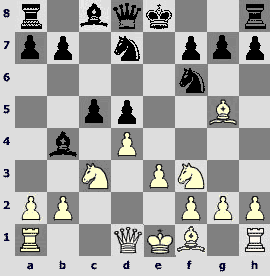
8.Ґe2?! This modest bishop development is hardly dangerous for Black. Correct is 8.Ґd3, as Teimour himself used to play.
8...Јa5 9.0–0 0–0 10.Јc2?! Better10.dxc5, with equality.
10...Ґxc3 11.bxc3 ¤e4 12.c4 cxd4 13.cxd5 ¦e8 14.¦ad1 h6 15.Ґh4. 15.Ґf4 dxe3 16.Ґxe3 ¤c3 also leads to the loss of a pawn, although the higher activity of the pieces permits to count on a draw.
15...dxe3 16.fxe3 ¤c3 17.Ґe1 ¦xe3 18.Ґd3 Јc5 19.Јxc3 ¦xe1+ 20.Јxc5 ¦xf1+ 21.Ґxf1 ¤xc5
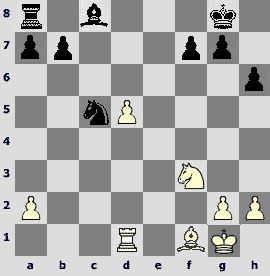
In the endgame the d5-pawn is not an asset but a weakness, the game's length should not mislead anybody: its outcome is clear. Levon has only to demonstrate his technique, which is upto the mark.
22.¤e5 ¤d7 23.¤c4 ¤f6 24.Ґe2 Ґd7 25.Ґf3 ¦d8 26.¤e5 Ґf5 27.d6 ¤d7 28.¤c4 b6 29.a3 ўf8 30.ўf2 ¦c8 31.¤e3 Ґe6 32.¤d5 ¦c2+ 33.ўg3 ¤e5 34.¤c7 Ґd7 35.¤a6 ўe8 36.¦e1 f6 37.¦e3 ўd8 38.Ґd5 ¦d2 39.¤c7 Ґf5 40.ўf4 g6 41.¦c3 ўd7 42.ўe3 ¦d3+ 43.¦xd3 Ґxd3 44.Ґe4 Ґxe4 45.ўxe4 ўxd6 46.¤b5+ ўc5 47.¤xa7 ¤c4 48.a4 ¤d6+ 49.ўd3 ўb4 50.ўd4 ¤f5+ 51.ўd5 ¤e3+ 52.ўe6 f5 53.¤c8 ¤xg2 54.¤xb6 f4 55.¤d5+ ўxa4 56.ўf6 f3 57.¤c3+ ўb4 58.¤e4 ¤h4 59.ўg7 h5 60.ўh6 ўc4 61.ўg5 ўd3 62.¤g3 ¤f5 63.¤h1 ¤e7 64.ўf6 ўe2 65.h4 ўf1 0–1
V. Topalov (2783) – V. Anand (2779) [E15]
1.d4 ¤f6 2.c4 e6 3.¤f3 b6 4.g3 Ґa6 5.b3 Ґb4+ 6.Ґd2 Ґe7 7.Ґg2 c6 8.Ґc3 d5 9.¤e5 ¤fd7 10.¤xd7 ¤xd7 11.¤d2 0–0 12.0–0 ¤f6 13.e4 dxe4 14.a4. White prevents the b6-b5 advance.
14...¤d5?! The idea is well-known, but dubious. The present game is another proof of this.
15.cxd5 Ґxf1 16.d6! Naturally if Black is permitted to take on d5, his pawn structure improves, and an advantage shifts to his side.
16...Ґxg2 17.dxe7 Јxe7 18.ўxg2 f5 19.b4
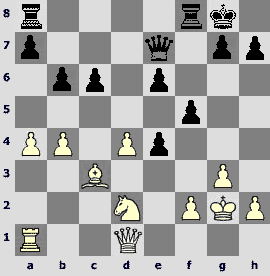
A fine novelty by Veselin Topalov, he prevents c6-c5, after which d4xc5 will readily follow, and then b4-b5.
19...Јd7 20.Јe2 Јd5 21.f3 exf3+ 22.¤xf3. White has a great advantage.
22...h6 23.¦e1 ¦fe8 24.Јc2 ¦ad8 25.Ґd2 Јd7 26.ўf2 ¦c8 27.Ґf4 Јd5 28.¦e5 Јd7 29.h4 ¦a8 30.Ґd2 ¦ac8 31.Јc4 ўh7 32.Ґc3 Јd6 33.¤e1
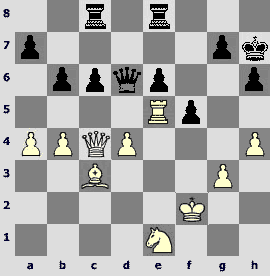
33...b5?! Now the с5-square weakens in addition, but, frankly speaking, Black's position could not become any worse.
34.Јc5 Јd8 35.¤d3 1–0
Anand's defeat is so submissive, he is so upset with the course of the struggle, that he cedes the game in a position with some minimal chances for salvation. At least, it is not customary to resign in such positions.
V.Kramnik (2766) – М.Carlsen (2690) [E04]
1.¤f3 ¤f6 2.c4 e6 3.g3 d5 4.d4 dxc4 5.Ґg2 a6 6.0–0 ¤c6 7.e3 Ґd7 8.¤c3 ¤d5 9.¤d2 ¤b6 10.Јe2 ¤a5
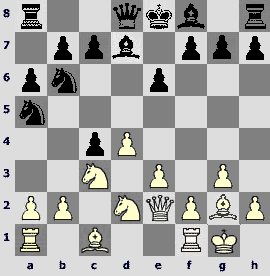
11.¤de4. A "self-suggesting" novelty; in Radjabov – Adams (Tripoli 2004) there was 11.e4 (with the knight on d2 this move does not look so very harmonious) 11...Ґb4 12.Јg4?! (after natural and strongest 12.¤f3 White has enough compensation for a pawn, but no more than that) 12...Јf6! 13.¤f3 h5!,and, having forced the transposition into an endgame, Black obtains an obvious advantage.
11...Ґe7. 11...Ґc6 is also worth testing in practice.
12.¤c5 Ґc6 13.Ґxc6+. A showy 13.¤xe6 would not be effective: 13...fxe6 14.Јh5+ g6 15.Јxa5 Ґxg2 16.ўxg2 0–0 with a black initiative.
13...¤xc6 14.¤xb7 Јc8 15.¤c5 0–0 16.¤5a4 ¤b4 17.Ґd2. It would have been stronger to struggle for light squares – 17.b3! with an advantage.
17...¦d8 18.a3 ¤c6. More reliable is 18...¤4d5, and white knights look somehow addled; on 19.¤c5 looks good 19...e5!
19.¦ac1 ¦b8 20.¦fd1. From the positional standpoint 20.f4 ¤a7 21.¤xb6 cxb6 22.¤b1 b5 23.b3 is risky– White wins a pawn, but Black obtains counterplay of light-colored squares and opening b-file.
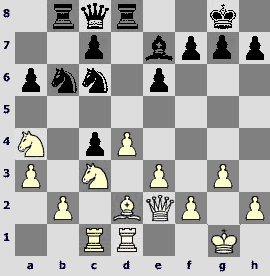
20...e5! 21.¤xb6 cxb6 22.Јxc4 exd4 23.¤e4 dxe3 24.Ґxe3 ¦xd1+ 25.¦xd1 Јb7. White seems more active, but still has nothing real.
26.¦c1 ¤e5 27.Јc7 f6 28.Јxb7 Ѕ–Ѕ
А.Motylev (2647) – P.Svidler (2728) [D70]
1.d4 ¤f6 2.c4 g6 3.f3 d5 4.cxd5 ¤xd5 5.e4 ¤b6 6.¤c3 Ґg7 7.Ґe3 0–0 8.Јd2 ¤c6 9.0–0–0 f5 10.e5. Once I managed to create a miniature in this variation: 10.h4 fxe4 11.h5 gxh5 12.d5 ¤e5 13.Ґh6 ¦f7?! 14.Ґxg7 ¦xg7 15.¦xh5 ¤bc4 16.Јd4 b5 17.¦xe5 ¤xe5 18.Јxe5, and White soon won. (Sakaev–Timofeev, Istanbul 2003). For Black it is stronger 13...¤ec4 14.Јg5 ¦f7, with an unclear position.
10...¤b4 11.¤h3 Ґe6 12.ўb1 Јd7 13.¤f4 Ґf7 14.a3 a5. Also possible is 14...¤4d5, with approximately even chances.
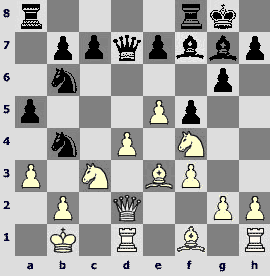
15.d5?? It is absolutely obvious that the b4-knight is not to be taken under any conditions, so Alexander's move is a mystery to me. Suggests itself15.h4, playing your own game where it should be played – on the kingside.
15...Ґxe5 16.axb4 axb4 17.¤b5 ¦a5 18.Ґxb6 cxb6 19.Јxb4 ¦fa8
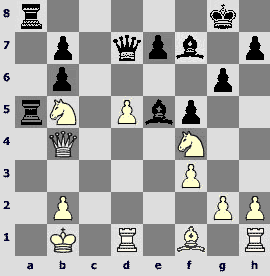
20.¦d4. A la guerre comme a la guerre, sometimes you have to throw yourself on the embrasure, but to change the outcome is already impossible.
20...Ґxd4 21.Јxd4 ¦a1+ 22.ўc2 ¦xf1 23.¦xf1 Јxb5 24.¦c1 ¦d8 25.Јe5 Ґxd5 26.¤xd5 ¦xd5 27.Јe6+ ўf8 28.Јc8+ ўf7 0–1
S.Каriakin (2678) – D.Navara (2719) [C88]
1.e4 e5 2.¤f3 ¤c6 3.Ґb5 a6 4.Ґa4 ¤f6 5.0–0 Ґe7 6.¦e1 b5 7.Ґb3 0–0 8.h3 Ґb7 9.d3 d6 10.a3 ¤d7 11.¤c3 ¤d4 12.¤xd4 exd4 13.¤e2 c5 14.Ґa2 ¦c8 15.¤f4 ўh8
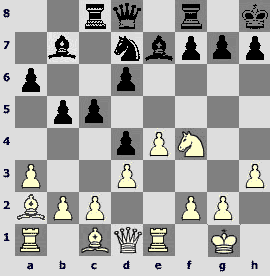
16.b4? It seems to me that originally the White's idea had been related to the pawn exchange on с5, after which Seriozha Kariakin meant to employ the e-pawn as a battering ram (e4-e5-e6). 16.Ґd5 permitted to retain a minimal advantage.
16...¤b6 17.¤e2?! It turns out that after 17.bxc5 dxc5 18.e5 c4 the a2-bishop is "offside", so White switch to another, no less disastrous, plan. It was necessary to finish development – 17.Ґd2, and there is no need to respond to 17...c4, meanwhile playing 18.¤h5 – Black has an advantage, but White is not without counterplay.
17...Јd7 18.Ґf4
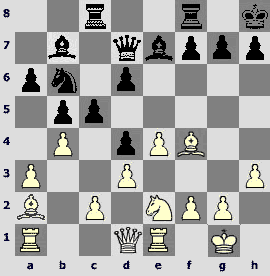
18...f5! Black passes to the offensive on all the fronts.
19.f3 fxe4 20.fxe4 cxb4 21.axb4 d5 22.e5! The best practical chance – or else White will be even worse.
22...Ґxb4 23.Ґd2 Ґc5 24.ўh1

24...¤c4! David is up to the mark for the time being.
25.Ґf4 ¤e3. It seems outwardly dangerous, but actually no less strong is 25...Јf5 26.¦f1 ¤xe5 27.¤g3 Јf6, retaining two extra pawns.
26.Ґxe3 dxe3 27.d4 Ґe7 28.Јd3 Ґh4 29.Јxe3. After 29.¦f1 Ґf2 White has not much of a chance either.
29...Ґxe1 30.¦xe1 Јf5 31.ўg1. Preventing the black queen from getting on f2. 31...Јe4 32.Јg3 Јg6 33.Јe3 Јe4 34.Јg3 ¦c6 35.Ґb1 ¦g6 36.c3 ¦xg3 37.Ґxe4 ¦e3 38.Ґf3 ўg8 39.ўf2 ¦d3 40.¦b1 Ґc6?! White is down an exchange, his pieces are constrained. ThepositioniseasilywonforBlack. Logical and simple would be 40...g5 with following ўg8-g7, h7-h5, etc. White can do nothing against Black's offensive on the kingside.
41.¦a1
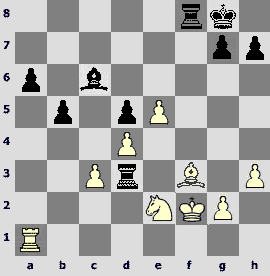
41...b4?? It was not too late to think better of it still – 41...Ґb7.
42.¦xa6 Ґe8 43.ўe1 bxc3 44.Ґxd5+ ўh8 45.¦a3. An advantage is already White's.
45...Ґa4 46.¦xa4 c2 47.Ґf3 ¦d1+ 48.ўf2 ¦c8 49.Ґc6 c1Ј 50.¤xc1 ¦xc1 51.d5 ўg8 52.e6 ¦1xc6 53.dxc6 ўf8 54.¦f4+ ўe8 55.¦f7 g6 56.c7 1–0
A very vexing defeat for David Navara, but sometimes it so happens that an advantage accumulated little by little in dozens of moves is wasted with a single move.
